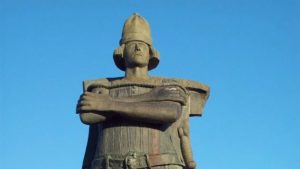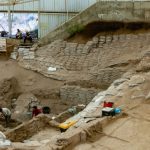 History
History  History
History  Weird Stuff
Weird Stuff 10 Everyday Products Surprisingly Made by Inmates
 Movies and TV
Movies and TV 10 Actors Dragged out of Retirement for One Key Role
 Creepy
Creepy 10 Lesser-Known Shapeshifter Legends from Around the World
 Animals
Animals 10 Amazing Animal Tales from the Ancient World
 Gaming
Gaming 10 Game Characters Everyone Hated Playing
 Books
Books 10 Famous Writers Who Were Hypocritical
 Humans
Humans 10 of the World’s Toughest Puzzles Solved in Record Time
 Mysteries
Mysteries 10 Scientific Mysteries We Don’t Fully Understand
 Weird Stuff
Weird Stuff 10 Celebrities Who Have Admitted to Alien Encounters
 History
History Ten Revealing Facts about Daily Domestic Life in the Old West
 Weird Stuff
Weird Stuff 10 Everyday Products Surprisingly Made by Inmates
 Movies and TV
Movies and TV 10 Actors Dragged out of Retirement for One Key Role
Who's Behind Listverse?

Jamie Frater
Head Editor
Jamie founded Listverse due to an insatiable desire to share fascinating, obscure, and bizarre facts. He has been a guest speaker on numerous national radio and television stations and is a five time published author.
More About Us Creepy
Creepy 10 Lesser-Known Shapeshifter Legends from Around the World
 Animals
Animals 10 Amazing Animal Tales from the Ancient World
 Gaming
Gaming 10 Game Characters Everyone Hated Playing
 Books
Books 10 Famous Writers Who Were Hypocritical
 Humans
Humans 10 of the World’s Toughest Puzzles Solved in Record Time
 Mysteries
Mysteries 10 Scientific Mysteries We Don’t Fully Understand
 Weird Stuff
Weird Stuff 10 Celebrities Who Have Admitted to Alien Encounters
Ten Mysterious Historical Questions We Still Can’t Answer
Where is Cleopatra’s tomb? Who made the devil’s footprints? What happened to Abigail Williams? If you don’t know about any of those queries yet, you are sure to after this surprising list of history’s most persistent mysteries.
Historians spend their careers studying life’s most important questions. Yes, there are plenty of major historical events that have been endlessly documented. (Both World Wars and the American Civil War come to mind, among many others.) But many more events throughout history are far less understood than we may think. And it’s not just ancient happenings, either. Some relatively recent mysteries from the last century still persist in the minds of historical investigators, readers, and amateur sleuths, too.
In this list, we’ll dive into ten of the most pressing historical questions that experts still haven’t been able to answer. No matter how much these ten items are studied, nobody can come away with a conclusive take. And as time keeps on passing us by, every day brings more certainty that the truth will probably never quite be known.
Related: Top 10 Of The Creepiest Disappearances Throughout History
10 What Fate Befell Abigail?
The Salem witch trials were a notorious chapter in colonial America. And even today, they remain shrouded in mystery—especially when it comes to the fate of Abigail Williams. In 1689, Samuel Parris arrived in Salem, Massachusetts, as a new minister. He was accompanied there by his daughter Betty and her cousin Abigail. For a while, life was normal.
But then strange occurrences plagued the girls in early 1692. They were found to be suffering from convulsions and speaking in tongues. That led the town doctor to conclude they were bewitched. Blaming the family slave, Tituba, the girls accused her of sending them into a life of witchcraft. She confessed and then quickly implicated two more women.
The madness escalated as more girls exhibited similar symptoms. Soon, even more individuals faced witchcraft accusations. Samuel Parris lost his job and left with Betty, who went on to lead a normal life. Meanwhile, Abigail Williams stayed behind. She began to play a significant role in the town by accusing 57 more people of witchcraft. However, after testifying in June 1692, Abigail vanished from historical records. Nobody ever heard from her again.
Today, experts suggest she may have acted out due to her powerless position in society and sought temporary control for attention or influence. Others theorize the symptoms displayed by Abigail and the other “afflicted girls” were caused by ergotism. That’s a condition that comes from consuming fungus-infected rye. Historians wonder whether that could have led to her untimely demise and, thus, her subsequent disappearance from historical accounts. But nobody knows for sure. As far as the records are concerned, she simply vanished![1]
9 Who’s Buried There?
Japan is home to ancient tombs called kofun. These tombs were all built from the 3rd to 7th centuries AD. Unlike the famous pyramids, these tombs have a unique keyhole design and vary in size. Some are just a few dozen feet long. Others stretch for thousands of feet. The largest kofun, known as Daisen Kofun, is located in Sakai, Osaka Prefecture. It measures over 1,500 feet (457 meters) in length and 1,000 feet (305 meters) in width. However, the identity of the person buried inside remains a mystery.
Traditionally, Emperor Nintoku, the 16th Emperor of Japan during the 4th century, has been associated with this tomb. Despite this belief, no academic or scientist has confirmed it. That’s because there have always been very strict regulations prohibiting entry into the tomb. The Imperial Household Agency, responsible for matters concerning the Imperial Family, has restricted archaeological research to the kofun’s surrounding moats since the 1970s.
However, there has been recent progress. In 2018, archaeologists were permitted to excavate the moats for ancient artifacts. And there has been talk of excavating the mound itself since 2020. This still has yet to occur, but that appears to be some level of progress toward figuring out who is buried inside. Thus, there is hope this long-standing enigma may finally be unraveled in the years ahead.[2]
8 Who Burned Down the House?
In Neolithic Europe, a puzzling trend emerged where people deliberately set fire to their own houses. This phenomenon, known as the “burned house horizon,” was particularly prevalent in the Cucuteni-Trypillia culture of Eastern Europe. Those people spanned modern-day Ukraine, Romania, and Moldova. But the reasons behind this burning behavior remain shrouded in mystery.
There are several possible explanations for this practice. The first two theories propose that the burnings were accidental. Perhaps they were caused by flammable materials or attacks by invaders. However, these explanations fail to account for the frequency of the burnings. Plus, there was always a scarcity of human remains found within the charred dwellings.
The remaining theories suggest that the burnings were intentional but for different purposes. One hypothesis suggests the houses were burned to strengthen their clay walls, thus making them more resistant to water. Another theory posits that fires were a form of pest control, fumigating the villages to eradicate insects and pests.
Additionally, the burnings might have served as a means to recycle old materials and create space. Or perhaps they were part of a religious ceremony meant to symbolize the end of a home’s life cycle. Whatever the case, the burned houses remain an enigmatic phenomenon. For centuries now, it has left archaeologists and historians intrigued by the motivations behind these deliberate acts of destruction. And considering how long ago it all happened, it’s likely we will never know the real answer.[3]
7 Where’s the Explorer?
Roald Amundsen was the famous Norwegian explorer who secured his spot in history by leading the groundbreaking 1911 expedition that reached the South Pole. However, his daring escapades did not end there. In 1926, he embarked on a perilous journey over the North Pole aboard a dirigible, an early airship. He was in it with an Italian aeronautical engineer named Umberto Nobile and an American financier named Lincoln Ellsworth.
After the flight, Amundsen and Nobile’s relationship soured. It resulted in a highly publicized feud over the leadership of the expedition. Despite their animosity, in 1928, Amundsen received the distressing news that Nobile’s airship, the Italia, had crashed during another Arctic exploration. Setting aside their differences, Amundsen and a French crew boarded a Latham 47 floatplane on June 18, 1928. They departed from Tromsø, Norway, to aid in the rescue operation. Tragically, neither the crew nor the aircraft were ever seen again.
Although it is widely believed the plane crashed in the Barents Sea, the precise location and cause of the incident remain unknown. No wreckage or bodies have been recovered. Despite intermittent search efforts and knowing the plane’s exact route, no evidence has ever been found.
In 2009, a team even employed an underwater robot to explore 45 square miles (116.5 square kilometers) of the seafloor in search of the plane’s remains. Sadly, their endeavors proved unsuccessful. The mystery of Roald Amundsen’s final flight endures now. It is shrouded in unanswered questions about the vast expanse of the unforgiving ice and sea.[4]
6 Where’d the Brothers Go?

João Vaz Corte-Real was a well-known 15th-century explorer who sailed for the Portuguese crown. He gained influential positions in the Azores Islands during his career at sea. Then, his three sons—Gaspar, Miguel, and Vasco Añes—followed in his footsteps as explorers. It appeared as if the entire family was destined for historical greatness. Sadly, the sons would soon meet a far worse demise.
In 1500, Gaspar Corte-Real embarked on a voyage to the North Atlantic. He had done so at the behest of King Manuel I of Portugal. Despite reaching Greenland, he couldn’t land due to heavy ice. So he turned for home. The next year, Gaspar led another expedition with three ships. Hindered once again by ice, he altered his course and finally reached new land. It was believed to be Newfoundland, but records are suspect. That’s because once he got there, he encountered native peoples. Gaspar captured around 50 of them, intending to enslave them. Tragically, he never returned to Portugal. The fate of his ship and all its men was lost to the seas.
In 1502, Gaspar’s brother Miguel took action. He organized a relief expedition with three vessels. After reaching the same shores where Gaspar had landed, the three ships split up to search. They agreed to regroup later at a specific point. However, history repeated itself when the other two ships returned, but Miguel’s vessel went missing.
After both immense tragedies, the third brother attempted a rescue mission. But even though the king dispatched more ships, he forbade the brother from joining. He simply did not want to lose a third brother to the sea in the same way. To this day, the destiny of the Corte-Real brothers remains shrouded in uncertainty. Historians presume shipwrecks, of course, but the specific details are a mystery. And the tragedy of the Corte-Real brothers sadly persists.[5]
5 What (or Who) Killed Lin Biao?
In the realm of puzzling plane crashes, one incident stands out: the Lin Biao incident. Lin Biao was a prominent general during the Chinese Communist Revolution. He played a crucial role in Mao Zedong’s triumph and subsequent rise to power. However, on September 13, 1971, tragedy struck and ended his life under suspicious circumstances. Lin Biao and his family perished in a plane crash over Mongolia. But the crash is more complicated than first meets the eye. And now, more than 50 years later, the mystery persists.
Initially, the Chinese government remained silent about Lin’s fate. It wasn’t until a full year after the crash that they disclosed the official version of events. Their claim about the death was a shocker too. They asserted Lin Biao died while attempting to escape to the Soviet Union after a failed coup and assassination plot against Mao Zedong.
Unsurprisingly, this explanation failed to convince many. The Soviet Union dispatched its own agents to investigate the crash because of it. However, their findings remained classified until the Cold War ended. Eventually, in the 1990s, it was confirmed that Lin Biao was indeed on the ill-fated flight. That at least dispelled rumors of back-room family executions or a secret imprisonment orchestrated by Mao. Nevertheless, the precise circumstances surrounding the Lin Biao incident and his untimely demise continue to shroud in mystery for historians and conspiracists alike.[6]
4 Who Made the Footprints?
On the chilly winter night of February 8, 1855, the residents of Devon, England, awoke to a snowy landscape. Near the River Exe, it was cold and bitter, and snow blanketed the ground. Yet, it wasn’t just the snow that caught their attention. There was a far more peculiar sight that stirred up curiosity, concern, and fear. Imprinted in the snow were tracks resembling cloven hoofs. Nobody could explain how they got there. And there was nothing along with those hoof marks—no footprints, say, from a person leading an animal. Immediately, many superstitious locals believed it was the work of the devil himself.
According to shocking newspaper reports from the time, these tracks were attributed to a bipedal creature and not a four-legged one. Even more disturbing, the tracks seemed to defy obstacles. They passed right through walls and started up again. They went over haystacks and rooftops and even crossed the river without much apparent pause.
Skeptics tried to figure out a sensible solution to the shocking find. Suspected culprits ranged from escaped badgers to a kangaroo that had gotten out of a private zoo. Another theory suggested that an experimental balloon released from the Davenport Dockyard had left behind mooring shackles, creating the hoof-like imprints. But that wouldn’t explain the consistent spacing of the tracks. Or is it all made up? Was it mass hysteria kicked into overdrive? Whatever the case, the true reason behind the “devil’s footprints” of Devon still remains a mystery to this day.[7]
3 Who Killed the Queen?
Anne Boleyn was the former Queen of England and wife of King Henry VIII. During her reign in power, she had a tumultuous relationship with Thomas Cromwell. He was the king’s chief minister and a key figure in the English Reformation. Despite once being allies, their association soured over time. Ultimately, it led to Anne’s execution for treason. And still today, the question remains: Did Cromwell orchestrate her downfall or simply carry out the king’s commands?
By 1536, Anne Boleyn had fallen out of favor with King Henry. That was primarily due to her failure to produce a male heir. Additionally, she had ideological differences with Cromwell, despite their previous alliance. Cromwell played a significant role earlier in facilitating Henry’s divorce from his first wife. That allowed him to marry Anne Boleyn in the first place. In return, she granted him a position of influence.
However, in 1536, Cromwell gathered evidence implicating Anne in multiple acts of adultery, including—allegedly—with her own brother. Found guilty, she was executed on May 19, 1536. That paved the way for Henry VIII to marry Jane Seymour just a few days later.
Although much of the evidence against Anne Boleyn was likely fabricated or obtained through torture, historians remain uncertain about Cromwell’s role in its collection. Did he deceive the king and conspire against a political rival? Or was he faithfully executing Henry’s wishes from the beginning? Understanding how Cromwell may have operated will give further insight into Henry VIII’s impactful and infamous reign. And it may just tell a deeper tale about Anne Boleyn’s life and death.[8]
2 Where’s the Tomb?
Cleopatra was, of course, one of the foremost legendary figures of ancient times. And she remains an enigma when it comes to her final resting place. According to Roman historians, after their defeat by Octavian in the Battle of Alexandria, both Cleopatra and her lover Mark Antony took their own lives. Cleopatra’s decision came later than her lover’s. She was driven by the knowledge that Octavian planned to exhibit her as a triumphant prize in Rome. While Octavian allowed the lovers to be buried together, it is uncertain if Antony was cremated rather than mummified. And where they were buried remains up for debate.
Ancient sources provide limited information on this matter. Presently, a heated disagreement persists among Egyptologists regarding the potential location of Cleopatra’s tomb. While some experts consider Alexandria the obvious choice, more recent attention has shifted toward the ruins of Taposiris Magna. That’s an ancient city featuring a grand temple dedicated to Osiris.
At Taposiris Magna, numerous tombs have already been discovered. They include a few mummies too. Thus, it’s natural to wonder whether one could be that of Cleopatra. Notably, a captivating find involved a pair of mummies buried side by side. They had been adorned entirely in gold leaf too. That would have been a very prestigious couple. But historians know they weren’t the ones we seek. But they provide a crucial hint as to the importance of Taposiris Magna.
Even though these particular individuals were not Cleopatra and Mark Antony, their prestigious status in Egyptian society sheds light on Taposiris Magna’s significance during Cleopatra’s era. That makes it a plausible contender for Cleopatra’s final resting place. And in recent months, even more discoveries at that site have left archaeologists pondering whether we really did just stumble upon the infamous ancient burial ground.[9]
1 What Doomed the Minoans?
Over a century ago, ancient remains of the Minoan Civilization were discovered by archaeologists on the Greek islands in the Aegean Sea. These findings revealed that the Minoans were a highly advanced civilization. They pioneered development in Europe at the time with their advanced writing system, impressive art, and grand palaces. They even had a plumbing system as early as 1800 BC. However, by the mid-15th century BC, the Minoans faced a rapid decline. Soon enough, it eventually led to the collapse of their entire civilization. Thus, that raises the question: why? What caused their downfall?
Initially, the prevalent belief was that a volcanic eruption on the island of Thera (now known as Santorini) was responsible. However, further research showed that Minoan life continued after the eruption. Then, additional factors were suggested to be at play. Some propose that the eruption triggered devastating tsunamis and altered the climate. That would have resulted in prolonged periods of cold, wet summers and subsequent crop failures.
And while the eruption’s occurrence itself is indisputable, that may not be the entire story here. Other scholars and experts argue a major earthquake caused the collapse of Minoan palaces. Alternatively, another hypothesis suggests the Minoans fell victim to invasions by mainland Greeks—specifically the Mycenaeans. That would thus attribute the civilization’s demise to explicitly human actions.
Still, nobody quite knows for sure. It remains uncertain whether a single cause or a combination of factors led to the downfall of Europe’s first extraordinary civilization. And considering the time period we’re talking about here, we may never fully know.[10]








